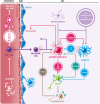The Potential Role of SARS-COV-2 in the Pathogenesis of Parkinson's Disease
- PMID: 33041985
- PMCID: PMC7527541
- DOI: 10.3389/fneur.2020.01044
The Potential Role of SARS-COV-2 in the Pathogenesis of Parkinson's Disease
Abstract
Considering their current burden and epidemiological projections, nowadays Parkinson's disease and the COVID-19 pandemic are two key health problems. There is evidence of the pathogenic role of neurotropic viruses in neurodegenerative diseases and coronaviruses are neurotropic, with some of them selectively targeting the basal ganglia. Moreover, some authors demonstrated the longevity of these viruses in the affected cells of the nervous system for long periods. Coronavirus was detected in brain autopsies and SARS-CoV-2 has been isolated from the CSF of affected patients. The marked inflammatory response in some particular patients with COVID-19 with a consequent increase of pro-inflammatory cytokines is considered a prognostic factor. Immunologic changes are observed in patients with Parkinson's disease, possibly having a role in its pathogenesis. A dynamic pro-inflammatory state accompanies α-synuclein accumulation and the development and progression of neurodegeneration. Also, some viral infectious diseases might have a role as triggers, generating a cross autoimmune reaction against α-synuclein. In the past Coronaviruses have been related to Parkinson's disease, however, until now the causal role of these viruses is unknown. In this paper, our focus is to assess the potential relationship between SARS-CoV-2 infection and Parkinson's disease.
Keywords: Parkinson disease; SARS virus; alpha-synuclein; coronavirus; movement disorders; nervous system diseases; neurodegenerative diseases; pandemics.
Copyright © 2020 Chaná-Cuevas, Salles-Gándara, Rojas-Fernandez, Salinas-Rebolledo and Milán-Solé.
Figures

Similar articles
-
Exploring the Paradox of COVID-19 in Neurological Complications with Emphasis on Parkinson's and Alzheimer's Disease.Oxid Med Cell Longev. 2022 Aug 31;2022:3012778. doi: 10.1155/2022/3012778. eCollection 2022. Oxid Med Cell Longev. 2022. PMID: 36092161 Free PMC article. Review.
-
Viral Infection-Induced Gut Dysbiosis, Neuroinflammation, and α-Synuclein Aggregation: Updates and Perspectives on COVID-19 and Neurodegenerative Disorders.ACS Chem Neurosci. 2020 Dec 16;11(24):4012-4016. doi: 10.1021/acschemneuro.0c00671. Epub 2020 Nov 27. ACS Chem Neurosci. 2020. PMID: 33244974 Review.
-
Linking COVID-19 and Parkinson's disease: Targeting the role of Vitamin-D.Biochem Biophys Res Commun. 2021 Oct 19;583:14-21. doi: 10.1016/j.bbrc.2021.10.042. Online ahead of print. Biochem Biophys Res Commun. 2021. PMID: 34715496 Free PMC article.
-
SARS-COV-2 infection and Parkinson's disease: Possible links and perspectives.J Neurosci Res. 2023 Jun;101(6):952-975. doi: 10.1002/jnr.25171. Epub 2023 Jan 30. J Neurosci Res. 2023. PMID: 36717481 Review.
-
The effect of SARS-CoV-2 on the development of Parkinson's disease: the role of α-synuclein.Hum Cell. 2024 Jan;37(1):1-8. doi: 10.1007/s13577-023-00988-2. Epub 2023 Sep 21. Hum Cell. 2024. PMID: 37735344 Review.
Cited by
-
Parkinson's Disease and SARS-CoV-2 Infection: Particularities of Molecular and Cellular Mechanisms Regarding Pathogenesis and Treatment.Biomedicines. 2022 Apr 26;10(5):1000. doi: 10.3390/biomedicines10051000. Biomedicines. 2022. PMID: 35625737 Free PMC article. Review.
-
Ecofriendly micellar mediated spectrofluorimetric method for ultrasensitive quantification of the antiparkinsonian drug safinamide in pharmaceutical formulation and spiked human plasma.Sci Rep. 2024 Jul 16;14(1):16460. doi: 10.1038/s41598-024-66462-7. Sci Rep. 2024. PMID: 39013989 Free PMC article.
-
Protein clearance strategies for disease intervention.J Neural Transm (Vienna). 2022 Feb;129(2):141-172. doi: 10.1007/s00702-021-02431-y. Epub 2021 Oct 23. J Neural Transm (Vienna). 2022. PMID: 34689261 Free PMC article. Review.
-
Emerging Neurological and Psychobiological Aspects of COVID-19 Infection.Brain Sci. 2020 Nov 12;10(11):852. doi: 10.3390/brainsci10110852. Brain Sci. 2020. PMID: 33198412 Free PMC article. Review.
-
Investigating neurological symptoms of infectious diseases like COVID-19 leading to a deeper understanding of neurodegenerative disorders such as Parkinson's disease.Front Neurol. 2022 Dec 7;13:968193. doi: 10.3389/fneur.2022.968193. eCollection 2022. Front Neurol. 2022. PMID: 36570463 Free PMC article. Review.
References
-
- Ray Dorsey E, Elbaz A, Nichols E, Abd-Allah F, Abdelalim A, Adsuar JC, et al. Global, regional, and national burden of Parkinson's disease, 1990–2016: a systematic analysis for the global burden of disease study 2016. Lancet Neurol. (2018) 17:939–53. 10.1016/S1474-4422(18)30499-X - DOI - PMC - PubMed
Publication types
LinkOut - more resources
Full Text Sources
Miscellaneous

